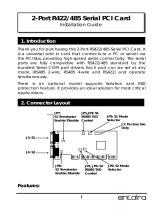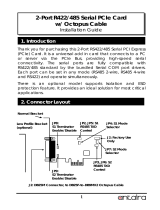
www.d.com
7
Chapter 1 Introduction
Specifications
Processor
System
7th Generation Intel
®
Core
TM
Processors, BGA 1440
Intel
®
Xeon
®
Processor E3-1535M v6, Quad Core, 8M Cache, 3.1GHz (4.2GHz), 45W
Intel
®
Core™ i7-7820EQ Processor, Quad Core, 8M Cache, 3.0GHz (3.7GHz), 45W
Intel
®
Core™ i5-7440EQ Processor, Quad Core, 6M Cache, 2.9GHz (3.6GHz), 45W
Intel
®
Core™ i5-7442EQ Processor, Quad Core, 6M Cache, 2.1GHz (2.9GHz), 25W
Intel
®
Core™ i3-7100E Processor, Dual Core, 3M Cache, 2.9GHz, 35W
Intel
®
Core™ i3-7102E Processor, Dual Core, 3M Cache, 2.1GHz, 25W
Chipset
• Intel
®
CM238 Chipset or Intel
®
QM175 Chipset
Memory
Two 260-pin SODIMM
• Supports dual-channel DDR4 2400MHZ
• Supports up to 32GB system memory
• Intel
®
CM238 supports ECC
Graphics
Intel
®
HD Graphics
OpenGL 5.0, DirectX 11, OpenCL 2.1
• Supports these codecs:
HW Decode: HEVC/H.265, H.264, M/JPEG, MPEG2, VC1/WMV9, VP8 (8-bit),
VP9 (10-bit)
HW Encode: HEVC/H.265, M/JPEG, MPEG2, VP8
• Output displays:
VGA: resolution up to 1920x1200 @ 60Hz
DVI-I: resolution up to 1920x1200 @ 60Hz
HDMI: resolution up to 4096x2160 @ 24Hz
DP: resolution up to 4096x2304 @ 60Hz
Triple/Dual
Display
VGA (+) DVI-D (DVI-I connector) or HDMI (+) HDMI or DP
Storage
• Two 2.5" SATA Drive Bay (support only HDD or SSD with 7mm thickness)
• SATA 3.0 port with data transfer rate up to 6Gb/s
Ethernet
• One Intel
®
I211IT PCIe (10/100/1000Mbps)
• One Intel
®
I219LM with iAMT11.0 PCIe (10/100/1000Mbps)
(only Intel
®
Xeon
®
and Core™ i7/i5 support iAMT)
Chapter 1
Note:
Please contact your sales representative for more information on the mounting kit,
which is not included in the standard model.
Power
• Power input voltage: 9~36V DC-in (terminal block connector)
Cooling
System
•
Fanless with heatsink
Environment
• Operating Temperature:
- 0 to 50°C (HDD)
- 20 to 60°C (SSD)
- 40 to 70°C (optional)
• Storage Temperature:
-20 to 85°C
• Relative Humidity:
5 to 95% RH (non-condensing)
• Shock:
Half sine wave 3G, 11ms, 3 shock per axis
• Vibration:
IEC68-2-64
Construction
• Metal + Aluminum
Mounting
• Wall mount
- Mounting brackets and screws
*
(optional)
Dimensions
•
235mm x 153.8mm x 222mm (W x H x D)
Weight
• 4.8 kg
BIOS
Insyde SPI 128Mbit
OS Support
• Windows 10 IoT Enterprise 64 Bit
• Linux (available upon request)
Other
Features
System Reset, Programmable via Software from 1 to 255 Seconds
Standards
and
Certications
Vibration: IEC68-2-64
Certicates: CE, FCC Class A, Microsoft Azure
Expansion
1 x PCIe x16 + 2 x PCI (EC531-KH only) or 2 x PCIe x16 (x1 and x8 signal)
+ 1 x PCI (EC532-KH only)
1 x M.2 2280 M key (PCIe x4 NVMe, Intel
®
Optane™ memory support)
One full-size/half-size Mini PCIe with mini SIM socket (PCIe &USB)
One full-size/half-size Mini PCIe with mini SIM socket (USB)
I/O Ports
Front:
• Two RS-232/422/485 (DB-9)
• Two USB 2.0 ports
• One status and HDD LED
• One power button with LED
• One reset button
• One remote switch
• Three antenna holes
Rear:
• One VGA port & DVI-D (DVI-I connector) & one HDMI
• Eight USB 3.0 Type A ports
• One Line-out and Mic-in Ports
• Six RS-232/422/485 (DB-9) (RS-232 with power)
• Two GbE ports (RJ-45)
• One 8-bit DIO
• One 9~36V DC-in 3-pole terminal block





















